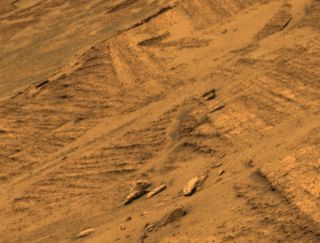

This is a picture of something any sedimentologist would recognize as a classic example of either cross-bedding or an angular unconformity (thanks to Ian Carr and Jackie Huntoon, who sorted out my misconceptions here...).
In cross-bedding, an advancing dune lays thin layers at an angle ('foresets') on its down-current face. This can be caused by either wind or water. The foresets are usually quite thin, and often occur in sets of sets, between bedding planes that are (or were) horizontal. Unfortunately, we can't see much lower - the section is buried in debris at the bottom.
In an angular unconformity, the lower layers (to the lower left in the frame) would have been laid down, tilted, and then eroded, cutting across the bedding (the diagonal discontinuity). The upper layers (in the upper right of the frame) were then laid down on top of this new surface. This is usually interpreted as physical evidence of at least tectonics and erosion, very possibly water-related.
These processes are common enough on Earth, but this is the Burns Cliffs inside Endurance crater on Mars. I'm amazed this didn't receive more press time than those incredibly cryptic "blueberries."
I'm sure that someone out there is doing numerical modeling of cross bedding for Mars, because there are a whole different set of physical constraints - different gravity, different viscosity of the air, windspeeds, etc. A lot of money has gone into this modeling for Earth, because of the oil industry, so there are probably a lot of starting points for budding Areologists...
Here is a (very large) image of some great soft sediment deformation - usually interpreted as a stream or river deposit, or at least a lake bottom with active slumping going on. The famous "blueberries" are quite prominent here - they were at first thought to be spatter from eruptions or impacts (like tektites), but some of their settings convinced the mission scientists that they were formed in place as concretions. Other physical evidence for water was the presence of vugs, or cavities where a crystal of some mineral deposited was later dissolved, leaving a hole.
It is very likely that similar cross bedding features exist on Titan, since there are liquids, winds, and enough body size for tectonics. However it is doubtful that we shall ever see them, since Huygens had no way to get around, much less usable battery power to do so. It was a feat just to get there and sit crippled on the surface while freezing to death.
...and yes, I feel sorry for the poor thing. I've felt sorry for them before (1, 2).
1 comment:
I am a sedimentologist by training and agree that the feature in the picture looks like cross-bedding. The process you describe however, is the formation of an angular unconformity. Which do you think it is?
Post a Comment